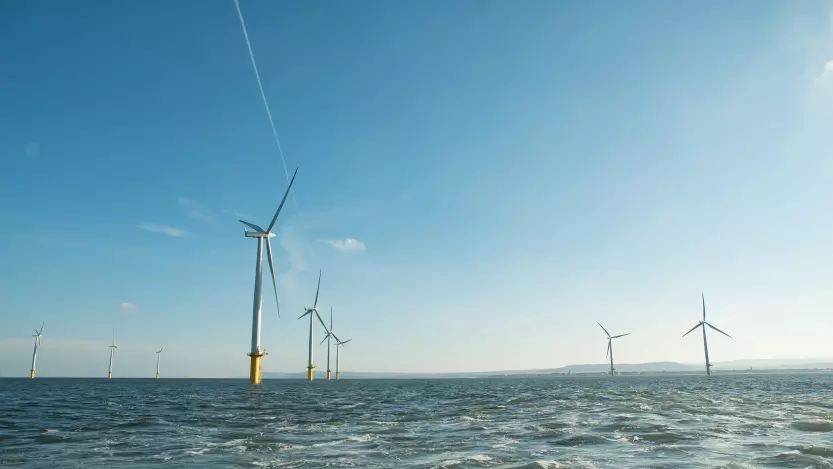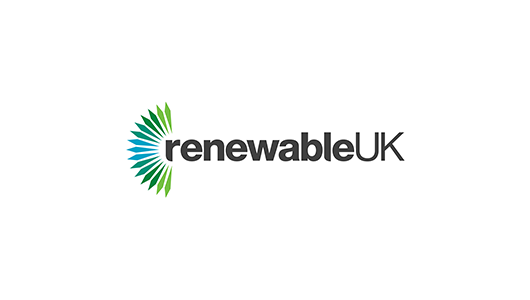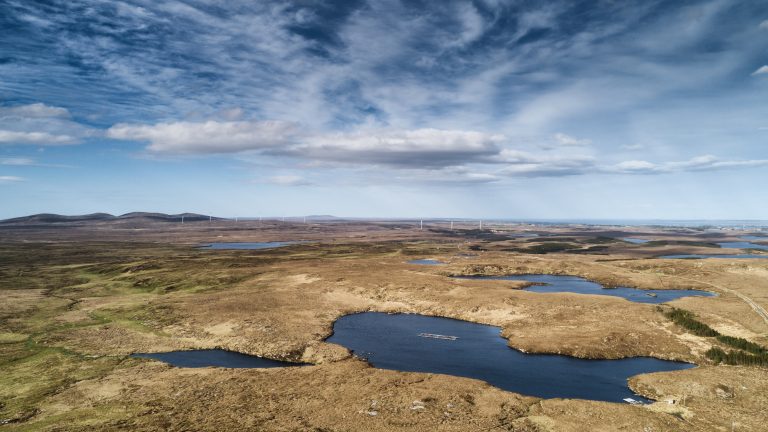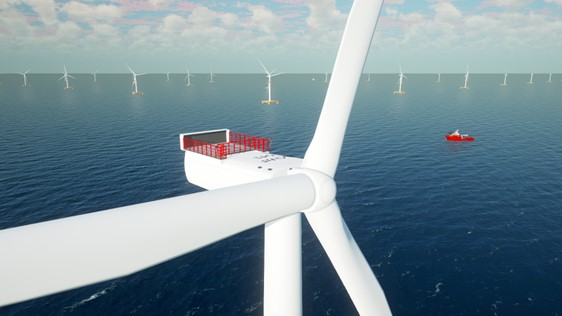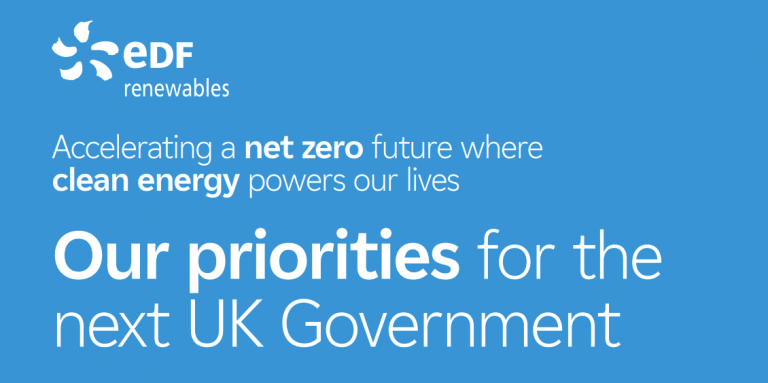
“The scale of offshore wind is immense – and it’s an ever-changing industry; nothing stands still,” says Ryanne Burges, Head of Offshore Development for EDF Renewables.
Find out what it’s like to work at the forefront of the renewables industry. The epic challenges involved in bringing an offshore wind project to fruition. And the immense satisfaction Ryanne gets – along with her team – from contributing to the UK, Scotland and Ireland’s 2050 net-zero targets.
Day-to-day working life in renewables
Q. Where are you right now?
A. I’m at my house, which is just outside Glasgow. Ordinarily I work at EDF Renewables’ Edinburgh office, at least 3 days a week, with the remainder of my time at home. So I was used to working from home before the Covid-19 outbreak. But I’m looking forward to going back into the office a couple of days a week soon.
Q. What does your job as Head of Offshore Development involve?
A. Well, interestingly I’m not based offshore! That’s because my role is focused on development. I look after all aspects of project origination, design and development prior to us actually constructing anything. For example, understanding whether or not it’s feasible to deliver an offshore wind farm in certain areas of the seabed. Overseeing the process of obtaining all the necessary rights and permissions. And, ultimately, securing a route to market for sale of the electricity once it’s generated.
Q. Would you like to spend time offshore?
A. No – I get seasick and I’m scared of heights! So I take my hat off to those who build and work on our wind farms offshore.
Q. What excites you about working in offshore?
A. The scale of offshore wind is immense. The sheer size of the foundations, the vessels you have to use – never mind, the power of the turbines or size of their blades. And it’s an ever-changing industry; nothing stands still. We used to think that 6 MW turbines were big. But the industry is getting ready to install 14-15 MW turbines in the water. It’s almost unfathomable to think of the logistics involved in getting such incredible machines to site and safely installed. Never mind the increased potential to power so many homes.
Q. What are the timescales of the projects you develop?
A. The challenge of delivery is not to be under estimated. It takes around eight years to go from the idea of a project to the start of construction. And that time involves a huge amount of human and financial investment. I’ve heard it said in the industry that when you reach the final investment decision to go into construction, it’s like reaching the top of Everest. And then the challenge for construction is getting back down safely. It’s so true.
Q. Why does it take so long?
A. Much of the timescale is led by the consent process because you have to be confident about the predicted impacts of a site on the natural environment. Some of the timings are unavoidable. You need to have two years of baseline survey data collection, for instance, in order to support any consent application for offshore construction and operations.
This data then needs to be analysed and understood; and potential mitigations need to be considered. And, of course, you also need to have a solid understanding of the physical environment and its implications for construction and operation activities – as well as the overall design of the project.
It’s quite a sequential process. In other countries, some of this front-end data collection and permitting is short-circuited by a more centralised system. With the Government and consenting authorities identifying specific sites for development and presenting these to industry – along with base levels of consent data and site characteristic information. But in England, Wales, Scotland and Ireland, it’s a developer-led process. This results in a more front-loaded and lengthy development process. So it’s up to developers to identify sites and obtain all required information and permits.

A snapshot into day-to-day working life in offshore development
Q. What’s a typical day like for you?
A. I’ll head into the office after dropping my daughter off at nursery. Then about 90% of my day is taken up with calls – and this was the case even before Covid. We’re working on a number of projects at any one time, so my role requires an oversight of everything the project teams are working on and their day-to-day delivery. It means I spend a huge amount of time speaking to people.
I did quite a lot of travelling before lockdown. For example, the acquisition and development work for the Codling project in Ireland meant I was flying to Dublin on at least a fortnightly basis for face-to-face meetings. Then, in-between, there could be travel to the EDF office in London where some of the offshore team and other parts of the business are based. There are also meetings or conferences with relevant Government departments and regulators – such as the Department for Business, Energy and Industrial Strategy (BEIS) or Ofgem. So I was off site a fair amount of time.
Q. What kind of hours do you work?
A. It might sound terrifying, but more often than not I’m ‘on duty’ one way or another from 6.30am to 11pm! But I do take time out in the morning to have breakfast with my daughter and take her to nursery. And I choose to collect her from nursery, do dinner, bath and bedtime with her, whenever possible. So I don’t mind picking up work again after 7pm. And I’m lucky that the role gives me this flexibility. But the nature of project work is that it’s always moving, so it’s not a regular 9-5pm job.
Q. How have you found life during Covid-19?
A. My daughter is three years old. So it was quite challenging juggling looking after her throughout lockdown when she was at home, with managing my workload and generally needing to be on calls for much of the day! But I shared duties with my husband. And since restrictions have eased, she’s returned to nursery, which has made managing my work and parenting roles a lot easier.
Your career journey into renewables
Q. Where did you begin your career?
A. I’m a lawyer by training. After graduating, I worked in private practice for one of the bigger firms –qualifying as an engineering and construction procurement lawyer. Funnily enough, one of my earliest projects after I qualified was the design and construction contracts for the building EDF Renewables is located in now.
My focus in private practice was on finalising contracts at the pre-construction phase. I initially worked mainly on large infrastructure projects – so PFI contracts for schools and hospitals. But when the market changed after 2008, I started work on smaller onshore wind projects. And, over time, I found the balance of what I was working on shifted. So I was spending 90% of my time working on renewables, and only 10% on infrastructure projects. Most of the time it was wind projects, but there was also some exposure to hydro, early CCS (carbon capture and storage) and solar.
Q. Did you stay in private practice?
A. No – I moved from private practice to work in-house for a company with offshore assets in the UK. I was their legal counsel and this role was really broad. I wasn’t just looking after the legal aspects of construction, but responsible for legal aspects of all areas of project delivery: from consent to land arrangements to construction contracts. It was a really wide-ranging job – but it gave me an opportunity to learn a lot more about project development.
I was doing this role just as the electricity market reform was crystallising, and moving from Renewables Obligations to Contracts for Difference (CfDs). So I was heavily involved in reviewing the policy and terms for CfD implementation. This gave me a great grounding in what this would look like for the industry – and how it would influence developer thinking, as well as project design and development. And I draw heavily on these learnings in my role now.
It was around this time that a Canadian company offered me a role as commercial manager, as they were looking to build their offshore portfolio in Europe. I wanted to move to a more commercial position and this job gave me a huge breadth of experience in delivering renewables projects around the world. I worked in projects in the Netherlands, Germany, Poland, America and Taiwan. But this also meant I was living on three time zones… And I had a one year-old at home. So I actively pursued opportunities near to Glasgow and found that EDF Renewables was looking for a Head of Offshore Development. So I started here last August.
Q. How is your role different at EDF Renewables?
A. My job now is far more around leading others to achieve results – rather than me actively being the person delivering the results. Sometimes I have the opportunity to roll my sleeves up and give hands-on support. But my role is focused on supporting the team to deliver positive outcomes. I really enjoy it. I enjoyed being a lawyer; but I find that my soft skills and ability to create relationships are where I am strongest. I also love working with people, so this job really draws on these skills.
Q. What skills does your legal background equip you with?
A. It’s been invaluable. It taught me to pay attention to detail, negotiation skills, how to deliver high-quality work to tight deadlines – not to mention presentation and communication skills. And I use these skills every single day.
Q. What would you recommend to a young person – or your daughter – if she was interested in a career in renewables?
A. I’d definitely encourage them into renewables as an industry. Why not be part of something that’s the future? And it’s also a well-supported sector – from a public and government perspective.
For a commercial role, I’d recommend doing a degree in either economics or law. But I also see a huge number of engineers successfully moving into non-engineering positions – so project management, project delivery and commercial roles.
Q. What did you study?
A. I studied law at university, and for my Highers, I studied maths, English, history, music and chemistry. I definitely struggled with chemistry; but I felt I needed a science in the mix. I wouldn’t have thought I’d see myself in a STEM industry after university, as it wasn’t on my radar. But I’d definitely encourage any young person to consider the renewables sector.
What’s it like to work in the renewables industry
Q. How does it feel to be working in renewables right now?
A. I’ve absolutely caught the renewables wave at the right time – a couple of times now! The spotlight is really on the sector post-Covid, with the green recovery, and there’s huge public support.
It’s really exciting, as it puts people’s feet to the fire from a policy perspective. So where there were known barriers to deployment before Covid – for instance, challenges to getting the level of offshore capacity consented so the UK can meet net-zero by 2050 – now, there’s a real impetus to find a route through this in a timely and well-balanced way.
Q. Do you think the industry could do more to promote diversity and inclusion?
A. I don’t see many women doing my role elsewhere. Usually it’d be me and 10 men sat around the table. But I feel that this is starting to change. And I can see EDF Renewables is making a lot of effort to ensure there’s a gender balance in the organisation. My team, for instance, consists of four women and three men.
And while there’s not a huge number of women working in this sector right now, I think it’s a very welcoming, non-judgmental environment to work in. Even if I am the only female in a room, I don’t feel in any way that it’s noticeable to anyone else. I don’t ever feel intimidated and I think people are hugely excited to see women doing these senior roles. So I would really encourage other women to pursue a career in this sector.
Q. Where are the challenges to promoting diversity and inclusion?
A. I think it’s around how we work. Being in a transactional role – like developing a project or working on acquisitions – doesn’t easily lend itself to part-time or flexible working. When I came back to work after having my daughter, I knew I’d have to work in a different role if I wanted to work three days a week. Or I could do my job – but I’d need to work full time.
I don’t think there’s a huge amount an employer can do because it’s the nature of project work. And I think it’s a UK thing too. The Scandinavian countries, for instance, are able to enjoy a better work-life balance. Because it’s generally accepted in those countries that everyone might take four weeks leave over the summer and business just stops for that period.
It’s an ethos around ring fencing time for family and home commitments that we just don’t seem to have in the UK. There’s no ‘off’ switch. The hardest time of my working day is usually between 5-7pm. This should be family time. But people are generally still working. And while there is understanding around family commitments, it can be challenging to get the balance right.
The good news is that post-Covid, a lot of employers seem to be more open to giving that flexibility now. There’s greater acknowledgement that people have families and the environment feels more supportive. Which can only be a good thing – and hopefully help more women (and men) feel confident about flagging their responsibilities outside work too.
Q. What’s your favourite part of the job?
A. It’s definitely seeing the positive outcomes from a project. In the absolute best case, this is a project that starts to generate power. Because the investment it’s taken to get to that point – in terms of time, energy and money – is huge. To see a project ultimately generating green power and powering thousands of homes is hugely rewarding.
But there are also so many other positive outcomes that might happen along the way. For instance, shaping policy change. Or the team achieving internal recognition for doing a really good job. Being there – and being part of achieving these positive outcomes – is really rewarding for everyone on the team.
Q. And what about your least favourite?
A. There’s very little I don’t like about my job, I genuinely love what I do! But if I had to pick out something I like least of all, I would probably say trying to understand some of the more technical elements of wind farm design and development – especially when it comes to the electrical system and grid connection processes. I do feel I have a gap in my technical knowledge here, so I would like to do some sort of further education in this area… Although when I’d fit in any learning right now, I don’t know!
Q. How is your role helping the UK, Scotland and Ireland achieve net-zero?
A. I’m lucky because my role is directly contributing to a net-zero future – and I can see tangible results. For instance, in Ireland, the government wants to generate 5 GW of offshore capacity by 2030, so they are on track to achieve net-zero emissions by 2050. And through the delivery of the Codling offshore wind project, EDF Renewables (along with our partners, Fred Olsen Renewables) could deliver about 1 GW of that. So it’s very clear how what we’re doing will help towards the long-term net-zero targets.
I’m also very lucky that I’m involved in supporting policy review and direction. So in my job I have the opportunity to help shape government policy and create an environment where we can grow offshore capacity to meet the UK’s net-zero goals.
Future developments in renewables
Q. How do you see the offshore wind sector developing in the future?
A. In order to reach net-zero, we have to deliver renewables capacity at scale. And offshore wind is one of the most significant contributors to this. Offshore sites can deliver anything from 800 MW to 3 GW of capacity (for example)– other renewable technologies simply aren’t able to offer that kind of scale.
The question of how we do that is interesting. Because obviously there are constraints to building out lots more offshore wind farms near shore. So we need to move projects further out from shore if we want to keep adding more capacity to the pipeline. Which means the projects will look and feel different to what’s been delivered over the last decade.
Q. In what ways will offshore wind farms look different?
A. There’s a lot of change still to come for offshore wind. And what everyone questions is, as the technology continues to grow, what’s the tipping point for turbine size? At the moment, we have 15 MW machines. And this is likely pushing up to 20 MW turbines in the next five to ten years. But beyond that, who knows? So I think we might see changes coming in from elsewhere – like floating offshore wind, co-location with hydrogen and a reduced carbon footprint from construction and operations with electric/hybrid vessels coming onto the market.
Q. Do you see a future for floating offshore wind?
A. Yes – I see a large role for floating offshore wind. Right now, every large scale offshore wind project has fixed foundations. So when you build them, you penetrate the seabed to fix the foundations for the turbine. But you can only do this within the parameters of certain water depths and ground conditions. So wind farms are typically in depths of 20-40 metres. And the next round of projects will be in depths of 40-60m as we move further from shore.
But when it comes to depths of 60m+, it isn’t really feasible from a technology or cost perspective to drill down and build fixed foundations. The physical environment – from a wave and wind perspective – is also different so far offshore. Which is where floating offshore wind comes in…
There are different types of design, but essentially the foundations that the turbines sit on ‘float’ below the sea surface. It’s an exciting area and we’re just starting our exploratory journey to find out what this technology means. EDF Renouvelables has a project in France under construction. And in the UK, we’re looking at what our first floating project might be and what floating technology we might use.
The design process is different too for floating offshore wind, since a floating platform typically has greater movement with the metocean conditions than a fixed foundation. So we have to ensure that the turbines – from a strength and load perspective – can manage that continual movement. And, of course, that they’ll work as efficiently as possible in these conditions.
One of the benefits of a floating platform though, is that you can erect the turbine on shore and then float it out to site. And in some ways, this is much safer than building and erecting turbines out at sea. But it’s still a developing area, so we’re exploring all options at the moment.
Q. And what about co-location?
A. One co-location option for offshore wind involves hydrogen. So we’d install an offshore wind farm next to hydrogen electrolysers and get hydrogen transported back onshore, where it could become a fuel cell for transport, for example. That’s a very nice virtuous circle, whereby renewable energy creates further renewable energy, and powers what used to run on carbon intensive fuels.
The challenge is that the hydrogen market isn’t really there yet. There’s not a huge route to market or demand for it. So large capacities of hydrogen from offshore wouldn’t have anywhere to go just now.
But this is definitely an area the industry is looking at and hopefully we’ll see a lot of pilot projects looking at where and when is the right time to consider co-location of offshore with hydrogen. EDF is involved in a pilot project in Germany at the moment – but we’re not doing anything in the UK just yet.
Q. And what about how offshore is funded – how might this change?
A. The more comfortable everyone becomes with offshore technology – and as the desire for using only green energy grows – how we generate revenue from offshore renewables will likely be different from the 2030s.
Since its inception in 2013, all offshore wind projects in the UK have – to at least some extent – been supported by CfDs. And I think the majority of projects in the future will still include some CfD support, at least through the next decade in pursuit of the 2030 UK targets.
But it’s likely we’ll start to see the continued increase of alternative revenue streams from corporate PPAs. So we’ll provide renewables directly to a private organisation, by co-location (like the hydrogen example, above). In addition, future offshore wind projects might be able to withstand greater levels of exposure to the volatility of trading power directly into the electricity market.

